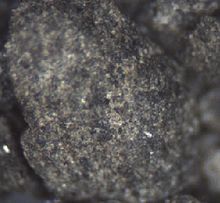- Muskiki Formation
-
Muskiki Formation
Stratigraphic range: Late Cretaceous
Muskiki_ShaleType Geological formation Unit of Smoky Group Underlies Bad Heart Formation Overlies Cardium Formation Thickness up to 99 metres (320 ft)[1] Lithology Primary Shale Other Sandstone Location Named for Muskiki Lake Named by D.F. Stott, 1963 Coordinates 52°47′47″N 116°53′33″W / 52.79637°N 116.89245°WCoordinates: 52°47′47″N 116°53′33″W / 52.79637°N 116.89245°W Region  Alberta
AlbertaCountry  Canada
CanadaThe Muskiki Formation is a stratigraphical unit of Late Cretaceous age in the Western Canadian Sedimentary Basin.
It takes the name from Muskiki Lake and Muskiki Creek, a tributary of the Cardinal River, and was first described in an outcrop along the Thistle Creek, north of Muskiki Lake, in the Bighorn Range, by D.F. Stott in 1963.[2]
Contents
Lithology
The Muskiki Formationis composed of shale with pebbly mudstone. Poorly sorted sandstone and concretionary beds also occur. In the western areal it becomes more silty.[1]
Distribution
The Muskiki Formation is 99 metres (320 ft) thick at its type locality at Thistle Creek. It thins out towards the south and east. It occurs in the Canadian Rockies foothills from the Highwood River in the south to the Berland River, north of the Athabasca River and into north-eastern British Columbia.[1]
Relationship to other units
The Muskiki Formationis is part of the Smoky Group. It is conformably underlain by the Cardium Formation and conformably overlain by the Bad Heart Formation.[1]
The Kaskapau Formation in northern Alberta replaces the upper Blackstone Formation, the Cardium Formation, and the Muskiki Formation.[3] Where the Kaskapau Formation includes post Cardium beds, the Muskiki is considered a member of the Wapiabi Formation.
References
- ^ a b c d Lexicon of Canadian Geologic Units. "Muskiki Formation". http://cgkn1.cgkn.net/weblex/weblex_litho_detail_e.pl?00053:010438. Retrieved 2009-03-05.
- ^ Stott, D.F., 1963. The Cretaceous Alberta Group and equivalent rocks, Rocky Mountain Foothills, Alberta Geological Survurvey, Canada, Memoir 317
- ^ Lexicon of Canadian Geological Units. "Kaskapau Formation". http://cgkn1.cgkn.net/weblex/weblex_litho_detail_e.pl?00053:007398. Retrieved 2009-02-06.
Western Canadian Sedimentary Basin Hydrocarbon history Depositional Regions Southern Alberta · Central Alberta · Northwestern Alberta Plains · South-central Canadian Rockies foothills · North-east Plains · North-central foothills · Liard River · Fort Nelson · Northern Rocky Mountains · Fort St. John · Saskatchewan · Western ManitobaNorthwest Plains Paskapoo FM · Scollard FM · Wapiti GRP · Smoky GRP (Puskwaskau FM · Badheart FM · Muskiki FM · Cardium FM · Kaskapau FM · Pouce Coupe MBR · Doe Creek MBR) · Dunvegan FM · Fort St. John GRP (Shaftesbury FM · Peace River FM · Spirit River FM) · Bullhead GRP (Bluesky FM · Gething FM · Cadomin FM) · Nikanassin FM · Fernie GRP (Rock Creek MBR · Poker Chip Shale · Nordegg MBR) · Schooler Creek GRP (Baldonnel FM · Charlie Lake FM · Halfway FM) · Doig FM · Montney FM · Belloy FM · Stoddart GRP (Taylor Flat FM · Kiskatinaw FM · Golata FM) · Rundle GRP (Debolt FM · Shunda FM · Pekisko FM) · Banff FM · Exshaw FM · Wabamun FM · Trout River FM · Kakisa FM · Redknife FM (Jean Marie MBR) · Woodbend GRP (Irteton FM · Fort Simpson FM · Leduc FM) · Beaverhill Lake GRP (Waterways FM · Swan Hills FM · Fort Vermilion FM) · Elk Point GRP (Watt Mountain FM · Gillwood MBR · Presqu’ile FM · Sulphur Point FM · Pine Point FM · Muskeg FM · Zama MBR · Black Shale · Keg River FM · Rainbow MBR · Chinchaga FM · Cold Lake FM · Ernestina FM · Basal Red Beds · Granite Wash) · Canadian Shield
This article about a specific Canadian geological feature is a stub. You can help Wikipedia by expanding it.

